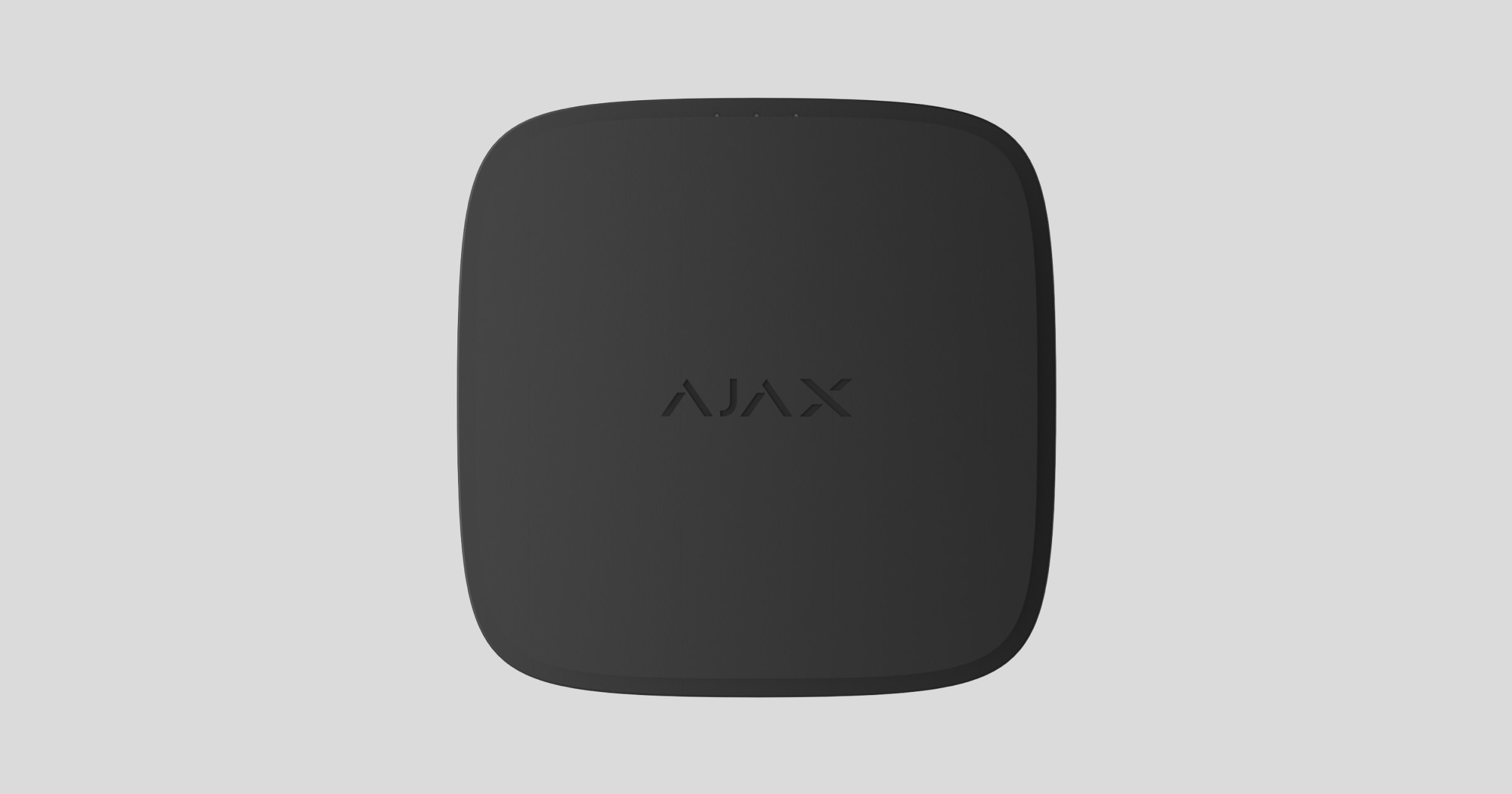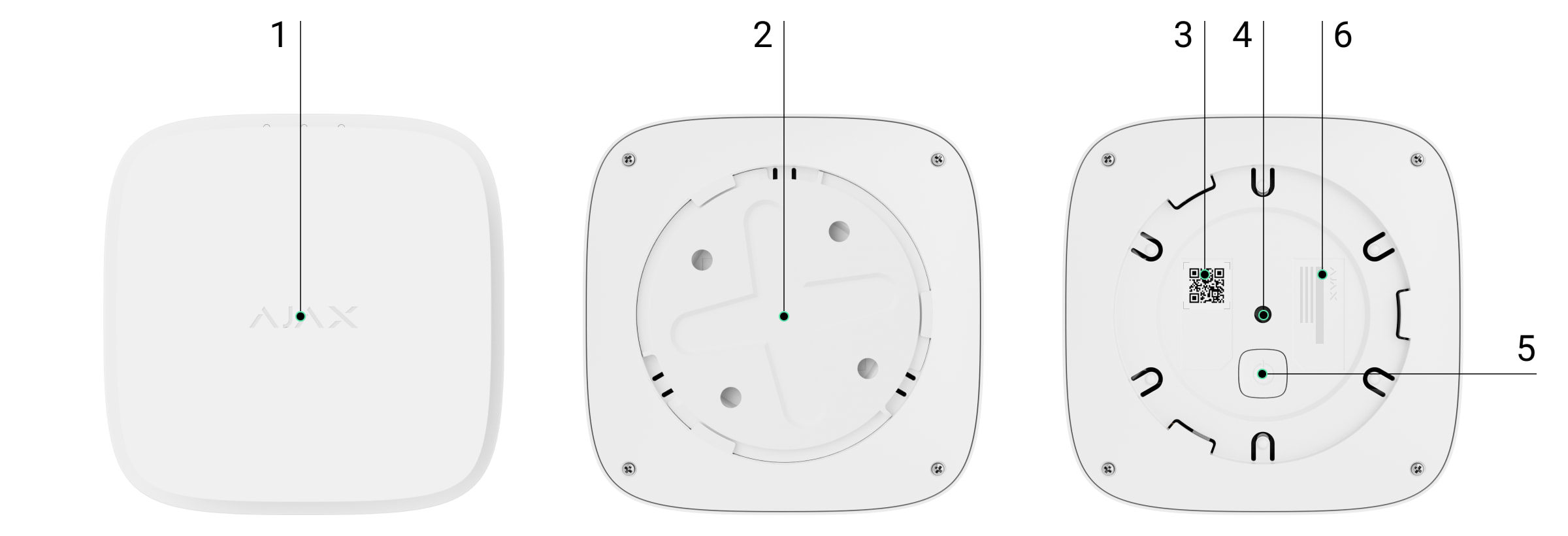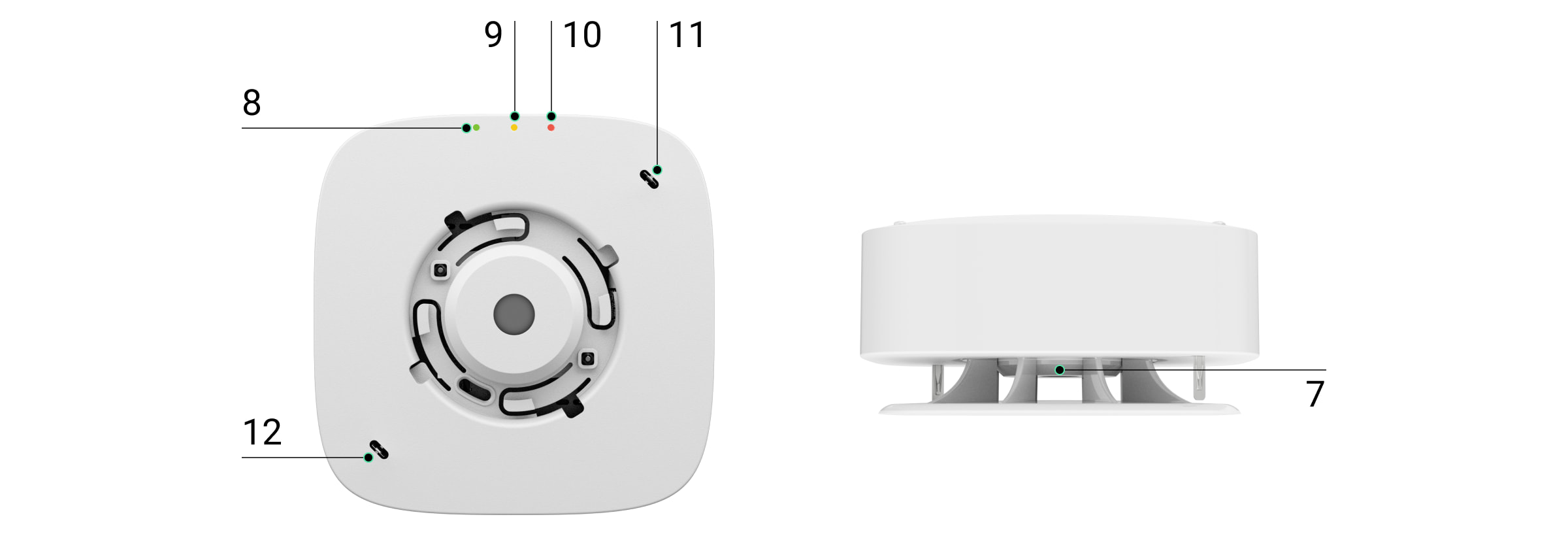FireProtect 2 (Heat) Jeweller, yerleşik sireni olan kablosuz bir yangın dedektörüdür. İç mekan kurulumu için tasarlanmıştır. Sıcaklık artışını algılar. Dedektör ayrıca bir hub olmadan da çalışabilir.
İki ayrı modifikasyonda mevcuttur: 10 yıl çalışan kapalı pillerle (adında SB vardır) ve 5 yıla kadar çalışan değiştirilebilir pillerle (adında RB vardır).
Uyumlu hub’ların ve kapsama alanı genişleticilerin listesine buradan ulaşabilirsiniz. FireProtect 2 (Heat) dedektörü yalnızca OS Malevich 2.15 ve sonrası işletim sistemi olan hub’lar* ile uyumludur. Hub (4G) Jeweller‘in bu dedektörü desteklemesi için OS Malevich 2.28 veya sonrası bir sürüme sahip olması gerekir.
Sadece FireProtect 2 RB (Heat) UL Jeweller dedektörü UL/ULC standartlarına göre sertifikalandırılmıştır ve OS Malevich 2.19 veya daha sonrası sürümdeki hub’larla uyumludur.
* Sadece Hub 2 Plus Jeweller ve Hub 2 (4G) Jeweller UL/ULC standartlarına göre sertifikalandırılmıştır.
Dedektör Ajax sisteminin bir parçası olarak çalışır ve Jeweller güvenli telsiz protokolü aracılığıyla hub ile iletişim kurar. Hub iletişim menzili, engel yoksa 5,577 ft kadardır.
Dedektörün farklı sensör kombinasyonları bulunan versiyonları da mevcuttur. Tüm Ajax yangın dedektörlerine buradan ulaşabilirsiniz.
İşlevsel unsurlar
- Test/Sessiz düğmesi bulunan dedektör ön paneli. Düğmeyi etkinleştirmek için panelin ortasına basınız.
- SmartBracket montaj paneli. Paneli çıkarmak için saat yönünün tersine çeviriniz.
- Cihaz QR kodu ve kimliği (seri numarası). Dedektörü Ajax sistemine eklemek için kullanılır.
- Tamper butonu. Dedektörü yüzeyden ayırmaya veya montaj panelinden çıkarmaya çalışıldığında tetiklenir.
-
Servis düğmesi.
- Dedektör sertifikasyon bilgileri.
- Siren.
- Yeşil LED gösterge.
- Sarı LED gösterge.
- Kırmızı LED gösterge.
- Birinci termistör. Tehlikeli sıcaklıkları algılar.
- İkinci termistör. Tehlikeli sıcaklıkları algılar.
Çalışma prensibi
FireProtect 2 (Heat) iç mekan kurulumu için tasarlanmış kablosuz bir yangın dedektörüdür. İki versiyonu mevcuttur:
- Kapalı pilli. Bu dedektörün adında SB vardır. Yerleşik pil ömrü 10 yıldır. Piller boşaldıktan sonra, dedektör yenisiyle değiştirilmelidir.
- Değiştirilebilir pilli. Bu dedektörün adında RB vardır. Hazır kurulu pil ömrü 5 yıldır. Piller boşaldıktan sonra, yenileriyle değiştirilebilirler.
Pil Ömrü Optimizasyonu* özelliği, yerleşik ve hazır kurulu piller için optimal bir kullanım ömrü sağlamak üzere etkinleştirilmelidir.
* UL sertifikalı FireProtect 2 dedektörleri için geçerli değildir.
Dedektör, alarmların ve olayların 85 dB’lik sesle (dedektöre 10 ft mesafe uzaklıkta) bildirimi için bir siren (piezoelektrik buzzer) ile donatılmıştır. Dedektör her zaman aktiftir ve sistemin güvenlik modundan bağımsız olarak 7/24 yangına tepki verir.
FireProtect 2 tamper ile korunmaktadır. Tamper, dedektörün SmartBracket montaj panelinden çıkarılmasını kontrol eder: Dedektör LED göstergesiyle tepki verir ve Ajax uygulamalarındaki kullanıcılara ve güvenlik şirketi izleme istasyonuna bildirimler gönderir.
Ajax otomasyon cihazları FireProtect 2 alarmlarına yanıt verir ve otomasyon senaryolarını kullanarak kullanıcı tanımlı eylemleri gerçekleştirir. Örneğin, WallSwitch rölesi bir alarm durumunda havalandırma sistemini ve acil durum aydınlatmasını açabilir.
Isı sensörü
Eşiği aşan sıcaklıkları algılayan iki yerleşik termistör. Bu termistörler, 135 °F (+58 °C) ile 174 °F (+79 °C) aralığında statik bir sıcaklık tespit edildiğinde alarm verir.
FireProtect 2, değeri 135 °F’yi (+58 °C) aşar aşmaz eşiği aşan bir sıcaklığı bildirir.
Test/Sessiz düğmesi
Test/Sessiz düğmesi ni etkinleştirmek için elinizle ön panelin ortasına hafifçe bastırın. Dedektöre elinizle ulaşamıyorsanız uygun bir araç (paspas sapı) kullanın. Test/Sessiz dedektörün ön panelinin altına yerleştirilmiş mekanik bir düğmedir.
Düğmenin birkaç işlevi vardır:
- Normal modda, dedektörün kendi kendine testini başlatır.
- Bir alarm durumunda, dedektör alarmını veya sistemdeki tüm yangın dedektörlerinin Birbirine Bağlı Alarmını 5 dakika boyunca susturur.
- Arıza veya düşük pil seviyesi durumunda, sesi ve LED göstergeyi 12 saat boyunca kapatır.
- Kullanım ömrünün sona ermesi durumunda, sesi ve LED göstergeyi 29 gün boyunca kapatır. Bundan sonra, gösterge kapatılamaz.
Kendi kendine testi çalıştırmak için dedektörü açtıktan sonra en az 3 dakika bekleyiniz.
Birbirine Bağlı Yangın Dedektörleri Alarmı*
UL/ULC standartlarına göre sertifikalı FireProtect 2 dedektörlerinde Birbirine bağlı yangın dedektörleri alarmı özelliği yalnızca bir hub ile çalışır.
FireProtect 2 ürün serisinin tüm yangın dedektörleri Birbirine Bağlı Alarm işlevini destekler. Bu işlev, yangın dedektörlerinden en az biri bir alarm algıladığında sistemdeki tüm yangın dedektörlerinin yerleşik sirenlerini etkinleştirir. FireProtect 2 dedektörlerinin sirenleri, bir alarm algılandıktan sonra 20 saniye içinde etkinleştirilir. FireProtect ve FireProtect Plus, Jeweller (veya Jeweller/Fibra) ayarlarında belirlenen dedektör ping aralığı sırasında, ancak en fazla 60 saniye sonra etkinleştirilir.
FireProtect 2 dedektörleri, kullanıcıların bunları ayırt etmesini kolaylaştırmak için farklı alarm türlerinde farklı ses ve LED göstergelere sahiptir. Birbirine bağlı alarm durumunda, FireProtect 2 dedektörleri, başlatıcı dedektör tarafından algılanan alarm türünü tam olarak gösterir. Başlatıcı dedektör ayrıca LED ile alarmı gösterir.
Olayları izleme merkezine gönderme
Ajax sistemi, alarmları ve olayları hem PRO Desktop izleme uygulamasına hem de Alarm İzleme Merkezine (AİM) SurGard (Contact ID), SIA DC-09 (ADM-CID), ADEMCO 685 ve diğer protokol formatlarında iletebilir. Desteklenen protokollerin listesi burada mevcuttur.
Ajax cihazlarının adreslenebilirliği sayesinde sadece olayları değil, cihazın türünü, atanan adını, sanal odasını ve güvenlik grubunu da PRO Desktop’a ve AİM’ye gönderilebilirsiniz. İletilen parametrelerin listesi AİM’nin türüne ve seçilen iletişim protokolüne bağlı olarak farklılık gösterebilir.
Kimlik ve dedektör loop (zon) numarası dedektör Durumlarında mevcuttur.
Sisteme ekleme
Bir cihaz eklemeden önce
- Ajax uygulaması‘nı yükleyin.
- Hesabınıza giriş yapın veya yeni bir hesap oluşturun.
- Bir space seçin veya yeni bir space oluşturun.
Space işlevi, aşağıda listelenen sürümler ve sonrası uygulamalarda mevcuttur:
- iOS için Ajax Security System 3.0.
- Android için Ajax Security System 3.0.
- iOS için Ajax PRO: Tool for Engineers 2.0.
- Android için Ajax PRO: Tool for Engineers 2.0.
- macOS için Ajax PRO Desktop 4.0.
- Windows için Ajax PRO Desktop 4.0.
- En az bir sanal oda ekleyiniz.
- Space’e uyumlu bir hub ekleyiniz. Hub’ın açık olduğundan ve Ethernet, Wi-Fi ve/veya mobil ağ üzerinden internete bağlandığından emin olunuz.
- Space’in çözülü olduğundan ve Ajax uygulamasında durumunu kontrol ederek Hub’ın güncelleme başlatmadığından emin olunuz.
Yalnızca bir PRO veya sistemi yapılandırma haklarına sahip bir space yöneticisi hub’a bir cihaz ekleyebilir.
Hub’a bağlanmak için dedektör, hub telsiz ağının kapsama alanı içinde olmalıdır. Cihazı telsiz sinyali kapsama alanı genişletici ile çalıştırmak için önce dedektörü hub ile ve ardından da genişletici ile eşleştiriniz. Bunu Ajax uygulamalarındaki kapsama alanı genişletici ayarlarından yapabilirsiniz.
FireProtect 2 bir hub’a nasıl bağlanır
- Ajax uygulamasını açınız.
- Birden fazla hub’ınız varsa veya Ajax PRO uygulaması kullanıyorsanız ilgili hub’ı seçiniz.
- Aygıtlar
sekmesine gidiniz. Aygıt Ekle‘ye basınız.
- Cihazın adını giriniz.
- QR kodunu tarayınız veya manuel olarak giriniz. QR kodu, muhafazanın arka kısmında (montaj panelinin altında) ve cihaz ambalajının üzerinde bulunur. Cihaz kimliği QR kodunun altında yer alır.
- Sanal odayı ve güvenlik grubunu (grup modu etkinleştirilmişse) seçiniz.
- Ekle‘ye tıkladığınızda geri sayım başlayacaktır.
Hub’a maksimum sayıda cihaz eklenmişse, cihazı eklediğinizde cihaz sınırının aşıldığına dair bir bildirim alırsınız. Hub’a bağlayabileceğiniz cihaz sayısı merkez ünite modeline göre değişir.
-
Servis düğmesine 3 saniye basılı tutarak dedektörü açınız. Hub bağlantı isteği yalnızca dedektör etkinleştirilmişse gönderilir. Dedektör hub ile eşleşmezse, 5 saniye içinde tekrar deneyiniz.
Farklı telsiz frekanslarında çalışıyorlarsa dedektör hub’a bağlanamaz. Cihazların telsiz frekansı aralığı satış bölgesine bağlıdır. Çalışma frekansı aralığı hakkında bilgi almak için lütfen Teknik Destek ile iletişime geçiniz.
Eklendikten sonra FireProtect 2, Ajax uygulamasındaki hub cihaz listesinde görünür. Cihaz durumu güncellemesi Jeweller veya Jeweller/Fibra ayarlarında belirlenen ping aralığına bağlıdır. Varsayılan değer 36 saniyedir.
FireProtect 2 tek bir hub ile çalışır. Yeni bir hub’a bağlandığında, dedektör eski hub’a komut göndermeyi durdurur. Yeni bir hub’a eklendiğinde, FireProtect 2 eski hub’ın aygıt listesinden kaldırılmaz. Bu, Ajax uygulamasında manuel olarak yapılmalıdır.
Otonom çalışma modu
FireProtect 2 dedektörleri bir Ajax hub’ına bağlanmadan otonom şekilde kullanılabilir. Bu durumda, dedektör yangını yalnızca yerleşik bir siren ve LED göstergesi ile bildirir. Kullanıcılar hiçbir Ajax uygulamasında, Ajax Translator ve PRO Desktop da dahil olmak üzere bildirim almazlar.
Dedektörü otonom olarak kullanmak için aşağıdaki adımları izleyiniz:
- Kurulum yerinin seçilmesi bölümündeki önerileri izleyerek dedektörün en uygun konumunu seçiniz.
- Dedektörü SmartBracket paneline Kurulum bölümünde açıklandığı gibi monte ediniz.
-
Dedektörü açmak için servis düğmesine basınız.
- En az 3 dakika bekleyiniz ve Test/Sessiz düğmesiyle kendi kendine testi başlatınız. Ön panelin ortasına basınız ve 1.5 saniye boyunca basılı tutunuz.
Kendi kendine test sırasında FireProtect 2 , yerleşik bir siren ve LED gösterge ile her adım hakkında bilgi verir. Kendi kendine test tamamlandığında, LED gösterge kapanır ve dedektör otonom olarak çalışır.
Bir alarm durumunda , sireni susturmak için Test/Sessiz düğmesine basınız veya alarmın nedenini ortadan kaldırınız.
Gösterge
LED’ler ve dedektörün yerleşik sireni, alarmların yanı sıra dedektörün belirli durumlarını da bildirebilir.
| LED gösterge | Ses gösterge | Olay | Notlar |
| Kırmızı LED her 1.5 saniyede bir 3 kez yanıp sönüyor. | Siren, LED göstergeyle eş zamanlı olarak çalıyor. | Alarm sebebi:
|
Dedektör, alarm kaynakları ortadan kalkar kalkmaz alarm vermeyi durdurur. Ayrıca, Test/Sessiz düğmesine veya Button Jeweller‘e basarak veya Ajax tuş takımlarını kullanarak alarmın sesini kapatabilirsiniz. LED ve ses göstergesi, susturma zamanlayıcısı (5 dakika) sona erdikten sonra alarm kaynağı hâlâ mevcutsa devam eder. |
| Kırmızı LED her 4 saniyede bir yanıp sönüyor. | Hayır. | Sessizleştirilmiş alarm. | Dedektör, alarm kaynağı ortadan kalkar kalkmaz alarm vermeyi durdurur. |
| Kırmızı LED üst üste 2 defa yanıp sönüyor. | Hayır. | Alarmdan sonra geri yükleme. | Alarm kaynağı ortadan kaldırılırsa, dedektör otomatik olarak geri yüklenir. |
| Sarı LED 1 saniye boyunca yanıyor. | Hayır. |
Kurcalama alarmı. Dedektör SmartBracket montaj panelinden çıkarılmıştır. |
|
| Yeşil LED 1 saniye boyunca yanıyor. | Hayır. | Dedektör SmartBracket montaj paneline yerleştirilmiştir. | Kurcalama tetiklendiğinde yanar. |
| Yeşil, sarı ve kırmızı LED’ler sırayla yanıyor, ardından kapanıyor. | Hayır. | Dedektör açılıyor. | Dedektörü açmak için servis düğmesini 1 saniye basılı tutun. |
| Yeşil, sarı ve kırmızı LED’ler sırayla yanıyor, ardından ters sırayla kapanıyor. | Hayır. | Dedektör kapatılıyor. | Dedektörü kapatmak için servis düğmesine 2 saniye basılı tutun. |
| Yeşil LED sürekli yanıyor. | Hayır. | Hub ile bağlantı kuruluyor. | Dedektör hub’a bağlandıktan sonra gösterge kapanır. |
| Yeşil LED üst üste 6 defa yanıp sönüyor. | Hayır. | Dedektör hub’dan çıkarılmıştır. | Dedektör, hub’dan çıkarıldığına dair bilgi aldığında gösterge yanar. |
| Sarı LED dakikada bir 2 defa yanıp sönüyor. | Siren, LED göstergeyle eş zamanlı olarak dakikada bir bip sesi çıkarıyor. | Arıza tespit edildi. |
Tüm arızalar, Ajax uygulamalarında dedektör durumlarında görüntülenir. Arızalı alanlar kırmızı renkle gösterilecektir. Dedektörün onarılması gerekiyor, lütfen Teknik Destek ile iletişime geçiniz. |
| Sarı LED dakikada bir kez yanıp sönüyor. | Siren, LED göstergeyle eş zamanlı olarak dakikada bir bip sesi çıkarıyor. | Düşük pil seviyesi. |
Yalnızca değiştirilebilir pillere sahip bir dedektörün (adında RB vardır) pillerini değiştirebilirsiniz. Kapalı pilli bir dedektör (adında SB olan), pilleri boşaldıktan sonra yenisiyle değiştirilmelidir. |
| Sarı LED sürekli olarak yanıp sönüyor. | Hayır | Piller tamamen bitmiş. |
Yalnızca değiştirilebilir pillere sahip bir dedektörün (adında RB vardır) pillerini değiştirebilirsiniz. Kapalı pilli bir dedektör (adında SB olan), pilleri boşaldıktan sonra yenisiyle değiştirilmelidir. |
| Kırmızı LED 5 defa yanıp sönüyor. | Siren 5 kez bip sesi çıkarıyor. | Kendi kendine test gerçekleştiriyor. | Test, Test/Sessiz düğmesine uygulamasındaki dedektör ayarlarından başlatılabilir. |
Dedektörü test etme
İşlevsellik testi
Bu test, dedektörün sensörlerinin durumunu kontrol etmenizi sağlar. Bunu iki şekilde çalıştırabilirsiniz: Dedektörün Test/Sessiz düğmesine basarak ve Ajax uygulamalarını kullanarak.
Kendi kendine testi çalıştırmak için dedektörü açtıktan sonra en az 3 dakika bekleyiniz.
Dedektör alarm durumundaysa, kendi kendine test kullanılamaz.
Test/Sessiz düğmesini kullanarak testi çalıştırmak için ön panelin ortasına basınız ve 1.5 saniye basılı tutunuz.
Testi Ajax uygulamasında çalıştırmak için:
- Ajax uygulamasını açınız.
- Birden fazla hub’ınız varsa veya Ajax PRO uygulaması kullanıyorsanız ilgili hub’ı seçiniz.
- Aygıtlar
menüsüne gidiniz.
- FireProtect 2 (Heat)‘i seçiniz.
- Dişli simgesine tıklayarak ayarlara gidiniz
.
- Cihaz Kendi Kendine Testi alanına tıklayınız.
Testi başlattıktan sonra dedektörün dedektörün kırmızı LED’i arka arkaya 5 kez yanıp söner. Dedektörün sireni, LED göstergeyle eş zamanlı olarak bip sesi çıkarır. Test bittiğinde, kullanıcılar Ajax uygulamalarında dedektör durumu hakkında bir bildirim alırlar.
Dedektör ayrıca test sonucunu ses ve LED göstergeleri ile bildirir. Test başarısız olursa ve bir arıza tespit edilirse, dedektör test başladıktan 3 saniye sonra bir arıza olduğunu göstermeye başlar: Sarı LED iki kez yanıp söner ve siren LED göstergeyle eş zamanlı olarak bip sesi çıkarır.
Kendi kendine test hemen başlamaz, ancak Test/Sessiz düğmesine basıldıktan veya Ajax uygulamasından çalıştırıldıktan sonra en geç 30 saniye içinde başlar.
Kendi kendine testi durdurmak için Test/Sessiz düğmesine tekrar basınız.
Kendi kendine test sırasında herhangi bir ses veya LED göstergesi oluşmazsa, dedektör kullanılamayabilir. Teknik Destek birimimizle iletişime geçiniz.
Kurulum yerinde test etme
Ajax sistemi, cihazların kurulum yerinin doğru seçilmesine yardımcı olmak üzere çeşitli testler sunar. Jeweller Sinyal Gücü Testi FireProtect 2 için kullanılabilir. Bu test, cihazı kurmak istediğiniz konumdaki sinyal gücü ve stabilitesini ölçer.
Testi Ajax uygulamasında çalıştırmak için:
- Birden fazla hub’ınız varsa veya Ajax PRO uygulaması kullanıyorsanız ilgili hub’ı seçiniz.
- Aygıtlar
menüsüne gidiniz.
- FireProtect 2 (Heat)‘i seçiniz.
- Dişli simgesine tıklayarak ayarlara gidiniz
.
- Jeweller Sinyal Gücü Testi ögesini seçiniz.
- Uygulamadaki yönergeleri takip ederek testi gerçekleştiriniz.
Test hemen başlamaz, ancak beklenen süre dedektör ping aralığı süresini aşmaz. Varsayılan değer 36 saniyedir. Dedektör ping aralığını hub ayarlarındaki Jeweller (veya Jeweller/Fibra) menüsünden değiştirebilirsiniz.
Simgeler
Simgeler bazı dedektör durumlarını gösterir. Bunları Ajax uygulamasındaki Aygıtlar sekmesinde görebilirsiniz.
| Simge | Anlamı |
|
Cihaz ile hub veya telsiz sinyali kapsama alanı genişletici arasındaki Jeweller sinyal gücü. Önerilen değer iki veya üç diştir. |
|
|
Cihazın pil şarj seviyesi. |
|
|
Birbirine Bağlı Yangın Dedektörleri Alarmı özelliği etkin. |
|
|
Dedektör Her zaman aktif modunda çalışıyor. Simge kalıcı olarak görüntülenir. FireProtect 2 her zaman aktiftir ve sistemin güvenlik modundan bağımsız olarak 7/24 yangına tepki verir. |
|
| Dedektör, bir telsiz sinyali kapsama alanı genişletici aracılığıyla çalışmaktadır. | |
|
Dedektör kalıcı olarak devre dışı. |
|
| Dedektör, sıcaklık eşiğinin aşıldığını tespit etmiştir. | |
| Dedektör SmartBracket montaj panelinden çıkarılmış veya muhafaza bütünlüğü başka bir şekilde ihlal edilmiştir. Dedektörün montaj panelini kontrol ediniz. | |
| Dedektörün sireni bir alarm sesini etkinleştirir. | |
| Arıza tespit edildi. Arıza listesi dedektör durumlarında mevcuttur. | |
|
Dedektörde kurcalama tetikleme olayları devre dışı bırakılmıştır. |
|
| Cihazın hub ile bağlantısı kesildi veya hub’ın Ajax Cloud sunucusu ile bağlantısı kesildi. | |
|
Cihaz yeni hub’a aktarılmamıştır. |
Durumlar
Bu durumlarda cihaz ve çalışma parametreleri hakkında bilgiler bulunmaktadır. Ajax uygulamalarında FireProtect 2 (Heat) durumlarını görebilirsiniz. Bunlara erişmek için:
- Ajax uygulamasını açınız.
- Birden fazla hub’ınız varsa veya Ajax PRO uygulaması kullanıyorsanız ilgili hub’ı seçiniz.
- Aygıtlar
sekmesine gidiniz.
- Listeden cihazı seçiniz.
Ajax uygulamaları FireProtect 2’nin iki ayrı sıcaklık parametresini görüntüler. Birincisi, dedektörün kurulu olduğu odadaki hava sıcaklığını gösterir. İkinci parametre olan Sıcaklık Eşiği Aşıldı, yangınla ilgili sıcaklık değişikliklerinin algılanıp algılanmadığını gösterir. Bu değerler odadaki sıcaklıktan farklı olabilir.
| Parametre | Anlamı |
| Verileri İçe Aktarma | Veriler yeni hub’a aktarılırken oluşan hatayı görüntüler:
|
| Sıcaklık |
FireProtect 2’nin kurulu olduğu tesisteki hava sıcaklığı. Uygulama ayarlarına bağlı olarak Celsius veya Fahrenheit derece cinsinden ölçülür. Normal durumda, sıcaklık değeri siyah renkte görüntülenir. Sıcaklık yükseldiğinde, bu kısım kırmızı renkle vurgulanır. Otomasyon cihazlarını kontrol etmek için sıcaklığa göre bir senaryo oluşturabilirsiniz. |
| Jeweller Sinyal Gücü |
FireProtect 2 ile hub veya telsiz sinyali kapsama alanı genişletici arasındaki Jeweller sinyal gücü. Önerilen değer iki veya üç diştir. Jeweller, FireProtect 2’nin olaylarını ve alarmlarını ileten bir protokoldür. |
| Jeweller üzerinden bağlantı | Jeweller üzerinden FireProtect 2 ile hub veya telsiz sinyali kapsama alanı genişletici arasındaki bağlantı durumu:
|
| Pil Şarjı | Cihazın pil şarj seviyesi:
Piller boşaldığında, kullanıcılar ve AİM bir bildirim alır. Dedektör normal koşullar altında düşük pil bildiriminden sonra bir ay daha çalışabilir. Bir alarm durumunda, pilin gücü ses ve LED göstergesini 4 dakikalığına çalıştırmak için yeterlidir. Yalnızca değiştirilebilir pillere sahip bir dedektörün (adında RB vardır) pillerini değiştirebilirsiniz. Kapalı pilli bir dedektör (adında SB olan), pilleri boşaldıktan sonra yenisiyle değiştirilmelidir. |
| Kapak | Cihazın yüzeyden ayrılmasına veya muhafazanın açılmasına tepki veren dedektör tamperlerinin durumu:
|
| Sıcaklık Eşiği Aşıldı | Sıcaklık eşiği aşılırsa alarm durumu:
Sıcaklık eşiğinin aşıldığı tespit edilirse metin alanı kırmızı renkle vurgulanır. |
| Kalıcı Devre Dışı Bırakma | Cihazın kalıcı devre dışı bırakma işlevinin durumunu gösterir:
|
| Aygıt yazılımı | FireProtect 2 aygıt yazılımı sürümü. |
| Cihaz kimliği | FireProtect 2’nin kimliği (seri numarası). Ayrıca dedektörün muhafazasında (montaj panelinin altında) QR kodunun altında ve ambalaj kutusunda da mevcuttur. |
| Cihaz No. | FireProtect 2 loop (zon) numarası. Olaylar AİM’ye bu numara ile gönderilir. |
Ayarlar
Ajax uygulamasında FireProtect 2 (Heat) ayarlarını değiştirmek için:
- Ajax uygulamasını açınız.
- Birden fazla hub’ınız varsa veya Ajax PRO uygulaması kullanıyorsanız ilgili hub’ı seçiniz.
- Aygıtlar
sekmesine gidiniz.
- Listeden cihazı seçiniz.
- Dişli simgesine tıklayarak Ayarlar bölümüne gidiniz
.
- Gerekli ayarları yapın.
- Yeni ayarları kaydetmek için Geri‘ye tıklayınız.
| Ayarlar | Anlamı |
| Adı |
Dedektörün adı. Hub cihazları listesinde, SMS metninde ve olay akışındaki bildirimlerde görüntülenir. Adı değiştirmek için metin alanına tıklayınız. Belirlenen isimde Kiril alfabesinden en fazla 12 veya Latin alfabesinden en fazla 24 karakter kullanılabilir. |
| Oda |
FireProtect 2’nin atandığı sanal odanın seçilmesi. Oda adı, SMS metninde ve olay akışındaki bildirimlerde görüntülenir. Odayı değiştirmek için alana tıklayınız. |
| Siren ile uyarı | |
| Maksimum sıcaklık eşiğine ulaşıldıysa | Bu seçenek etkinleştirildiğinde, dedektör bir sıcaklık eşiği aşımı tespit ederse sisteme bağlı Ajax sirenleri aktifleşir. |
| Jeweller Sinyal Gücü Testi |
Dedektörü Jeweller sinyal gücü testi moduna geçirir. Bu test, FireProtect 2’nin kurulumu için en uygun yerin belirlenmesine yardımcı olur. Bu test, Jeweller kablosuz veri aktarım protokolü aracılığıyla dedektör ile hub veya telsiz sinyali kapsama alanı genişletici arasındaki sinyal gücünü gösterir. Önerilen değer iki veya üç diştir. |
| Cihaz Kendi Kendine Testi |
Dedektörün kendi kendine testini çalıştırır. |
| Kullanım Kılavuzu | Ajax uygulamasında FireProtect 2 Kullanım Kılavuzunu açar. |
| Kalıcı Devre Dışı Bırakma |
Kullanıcının cihazı sistemden çıkarmadan devre dışı bırakmasını sağlar. Üç seçenek mevcuttur:
|
| Cihazı sil | FireProtect 2’nin eşleştirmesini kaldırır, hub ile bağlantısını keser ve ayarlarını siler. |
Pil ömrü optimizasyonu ayarı
Pil Ömrü Optimizasyonu özelliği, dedektörlerin pil şarjını korumak için sunulmuştur. Yalnızca FireProtect 2 dedektörlerinin bağlı olduğu OS Malevich 2.14 veya sonrası hub’lar için kullanılabilir. Bu özellik varsayılan olarak etkindir.
Pil Ömrü Optimizasyonu özelliği etkinleştirildiğinde hub, FireProtect 2 dedektörleri için ping aralığını artırır.
Bu özellik, alarm bildirimi teslim süresini etkilemez.
Pil Ömrü Optimizasyonu özelliğini devre dışı bırakmak için:
- Ajax uygulamasını açınız.
- FireProtect 2 dedektörlerinin bağlı olduğu hub’ı seçiniz.
- Şuraya gidiniz:
Hub → Ayarlar
→ Servis → Yangın Dedektörleri Ayarları.
- Pil Ömrü Optimizasyonu geçişini devre dışı bırakınız.
- Yeni ayarları kaydetmek için Geri‘ye tıklayınız.
Pil Ömrü Optimizasyonu özelliği devre dışı bırakılırsa:
- FireProtect 2 SB (Heat) yerleşik pil ömrü 5 yıl olur (10 yerine).
- FireProtect 2 RB (Heat) hazır kurulu pil ömrü 3.5 yıl olur (7 yerine).
Pil Ömrü Optimizasyonu özelliği , UL sertifikalı FireProtect 2 dedektörlerine uygulanamaz. Bunlar hazır kurulu pillerle 5 yıla kadar çalışırlar.
Kurulum yerinin seçilmesi
Cihaz, sadece iç mekan kurulumu için tasarlanmıştır.
Bir FireProtect 2’nin (Heat) kapsama alanı, tesisin türüne bağlı olarak 538–646 sq. ft.
Dedektör, gaz/buhar/duman oluşumunun operasyon sürecinin bir parçası olduğu tesislere kurulum için uygundur. Örneğin bir garajda, mutfakta, kazan dairesinde veya kazan odasında. Dedektör tavanın ortasına, aydınlatma armatürlerinden, avizelerden veya alarmın algılanmasını engelleyebilecek diğer dekoratif nesnelerden 12″ uzaklığa yerleştirilir.
Tavanda 12″ veya daha fazla çıkıntı yapan kirişler varsa dedektör her iki kiriş arasına monte edilmelidir. Kirişlerin çıkıntısı 12″ daha az ise tavanın orta kısmındaki bir kiriş üzerine kurulum yapılabilir.
Salonlarda veya dar koridorlarda, dedektörler birbirlerinden en fazla 24.6 ft uzaklığa kurulmalıdır.
Tavan eğimli ise dedektör tavanın en üst noktasından 23.6″ uzağa monte edilir. Kurulum yerini seçmek için tavanın üstünden aşağıya doğru düz bir çizgi çiziniz. Ardından, bu çizgiden tavanın eğimli kısmına bir dikey çizgi çekiniz. Dedektör bu noktaya monte edilir.
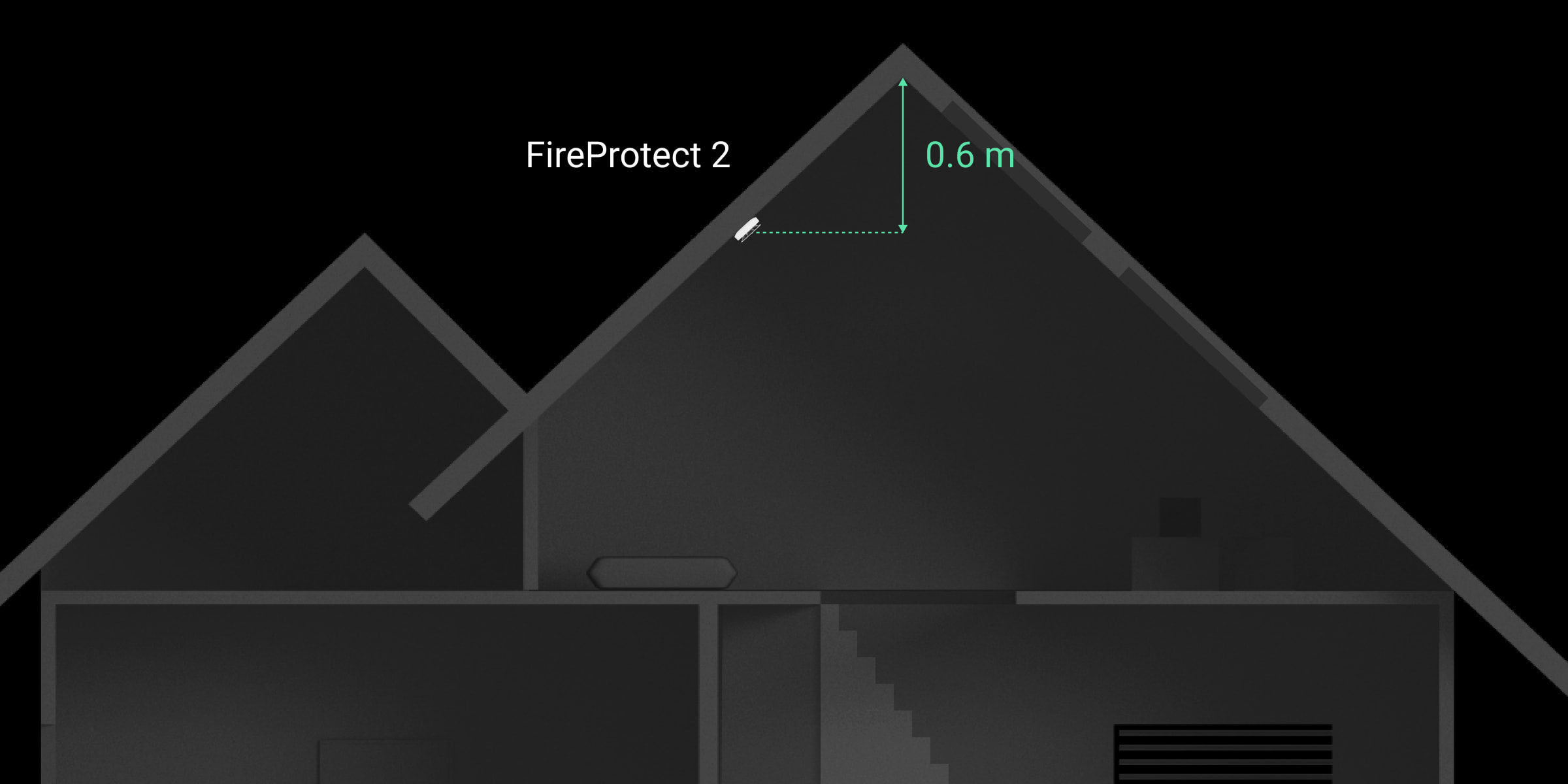
Dedektörün duvara monte edilmesini önermiyoruz. Ancak yakın aralıklı kirişler veya diğer engeller dedektörün kurulumunu engelliyorsa buralara montaj kabul edilebilir. Duvara montaj, sadece dedektör tavanın 6–12″ altına ve kapı aralıklarının üstüne yerleştirilirse mümkündür.
Duvara montaj yaparken LED’lerin kullanıcılar tarafından görülebildiğinden emin olunuz. Bu, FireProtect 2’nin baş aşağı kurulması gerektiği anlamına gelir.
Dedektör için bir konum seçerken onun çalışmasını etkileyen parametreleri göz önünde bulundurunuz:
- Jeweller sinyal gücü.
- Dedektör ile hub arasındaki mesafe.
- Cihazların arasındaki telsiz sinyallerinin geçişinin önündeki engeller: Duvarlar, katlar arası tavanlar, odada bulunan büyük nesneler.
Nesne için Ajax sistemi projesini tasarlarken yerleştirme önerilerini dikkate alınız. Güvenlik sistemi uzmanlar tarafından tasarlanmalı ve kurulmalıdır. Önerilen Ajax iş ortaklarının listesine buradan ulaşabilirsiniz.
Sinyal gücü
Jeweller sinyal gücü, hub ile dedektör arasında belirli bir süre içinde takas edilen ulaşmamış/bozulmuş veri paketlerinin sayısı, beklenen rakamlara oranlanarak belirlenir. Sinyal gücü Aygıtlar
sekmesindeki simgelerle gösterilir:
- Üç diş — mükemmel sinyal gücü.
- İki diş — iyi sinyal gücü.
- Bir diş — düşük sinyal gücü, stabil çalışma garanti edilmez.
- Çarpı işaretli simge — sinyal yok; stabil çalışma garanti edilmez.
Kurulum yerinde Jeweller sinyal gücünü kontrol ediniz. Sinyal gücü bir veya sıfır diş olduğunda, cihazın düzgün çalışacağını garanti etmiyoruz. Bu durumda cihazın yerini değiştiriniz. Yerin 8 inç kadar değiştirilmesi bile sinyal alımını önemli ölçüde iyileştirebilir.
Yer değişiminden sonra bile sinyal gücü düşük veya dengesizse, telsiz sinyali kapsama alanı genişletici kullanınız.
Dedektörü şu yerlere kurmayınız
- Dış mekan. Bu, dedektör arızalarına yol açabilir.
- Düşük veya dengesiz Jeweller sinyal gücü olan yerler. Bu, bağlantı kaybına neden olabilir.
- Sıcaklık ve nem koşulları kabul edilebilir sınırların dışında olan binalar. Bu dedektöre zarar verebilir.
- Hızlı hava sirkülasyonu olan yerlere. Örneğin, pervanelerin, açık pencerelerin veya kapıların yakını. Bu, yangın algılamayı engelleyebilir.
- Sıcaklığı hızla değişen nesnelerin karşısına. Örneğin, elektrikli ve gazlı ısıtıcılar. Bu yanlış alarmlara yol açabilir.
- Odanın köşeleri. Bu, yangın algılamayı engelleyebilir.
- Banyolarda, duş yerlerinde veya sıcaklığın hızla değiştiği diğer alanlarda. Bu yanlış alarmlara yol açabilir.
- Aydınlatma armatürlerinin, dekorasyonların ve odadaki hava dolaşımını engelleyebilecek diğer iç mekan eşyalarının yakınında. Bu, yangın algılamayı engelleyebilir.
- Genellikle odanın geri kalanından daha sıcak veya daha soğuk olan yüzeylerde. Örneğin çatı brandaları. Sıcaklık dalgalanmaları yangın algılamayı engelleyebilir.
- Yüksek veya uygunsuz yerlerde. Alarmı sessize almak ve bir hub’a bağlı olmadan kullanılıyorsa dedektörü test etmek için Test/Sessiz düğmesine ulaşabilmek gerekir.
Kurulum
En uygun kurulum yerini seçtiğinizden ve bu kılavuzda belirtilen gerekliliklere uyduğunuzdan emin olunuz.
Bu cihaz sadece yetkili bir uzman tarafından kurulmalıdır.
Dedektörü kurmak için:
- SmartBracket montaj panelini dedektörden çıkarınız. Paneli çıkarmak için saat yönünün tersine çeviriniz.
- SmartBracket panelini çift taraflı bant veya başka geçici bağlantı elemanlarıyla bir yüzeye sabitleyiniz. Montaj panelinde doğru konumu gösteren UP işareti vardır.
Yalnızca geçici sabitleme için çift taraflı yapışkan bant kullanınız. Yapışkan bantla sabitlenen cihaz, her an yüzeyden sıyrılabilir ve bu da cihazın düşürülmesi durumunda hasara yol açabilir.
- Jeweller sinyal gücü testini çalıştırınız. Önerilen değer iki veya üç diştir.
Sinyal gücü bir diş veya daha az olduğunda, dedektörün düzgün çalışacağını garanti etmiyoruz. Cihazın yerini değiştirmeyi düşünün, çünkü 8 inç bir konum değişimi bile sinyal gücünü önemli ölçüde artırabilir. Yer değişiminden sonra bile iyi ve stabil sinyal alamıyorsanız, telsiz sinyali kapsama alanı genişletici kullanınız.
- Dedektörü montaj panelinden çıkarınız.
- SmartBracket panelini tüm sabitleme noktalarından yararlanarak birlikte verilen vidalarla takınız. Başka tutturucular kullanırken bunların paneli zedelemediğinden veya kırmadığından emin olunuz.
- Dedektörü SmartBracket montaj paneline yerleştiriniz.
- Gerekirse dedektörün konumunu ayarlayınız.
Kurulum tamamlandıktan sonra bir kendi kendine test yapılması gerekir.
Yangın alarmı durumunda yapılması gerekenler
ALARMI HİÇBİR ZAMAN YOKSAYMAYIN! Bunun gerçek bir yangın alarmı olduğunu ve alarm sinyalinin nedeni hakkında şüpheniz olsa bile derhal binayı tahliye etmeniz gerektiğini varsayın.
- Arkalarında ısı veya duman hissederseniz kapıları açmayın. Diğer girişleri kontrol edin ve kaçmak için alternatif bir yol kullanın. Çıkarken tüm kapıları arkanızdan kapatın.
Bir oda yoğun duman altında kalırsa, zemine yakın durun ve sürünerek dışarı çıkın. Mümkünse ıslak bir bezi maske gibi kullanarak nefes alın veya nefesinizi tutmaya çalışın. Lütfen unutmayın, daha fazla insan yangından çok duman soluma nedeniyle hayatını kaybetmektedir.
- Binayı mümkün olduğunca çabuk tahliye edin, panik yapmayın. Zaman kaybetmeyin, eşyalarınızı toplamayın. Binadaki herkes için dışarıda bir toplanma yeri ayarlayın. Herkesin güvenli bir şekilde çıkıp çıkamadığını kontrol edin.
- Derhal itfaiyeyi arayın veya yakındakilerden yardım isteyin. Unutmayın, en küçük yangın bile hızla yayılabilir, bu nedenle itfaiyeyi aramayı ihmal etmeyin. Alarm otomatik olarak bir izleme istasyonuna iletilmiş olsa bile itfaiyeyi arayın.
ASLA yanan eve tekrar girmeyin.
Arızalar
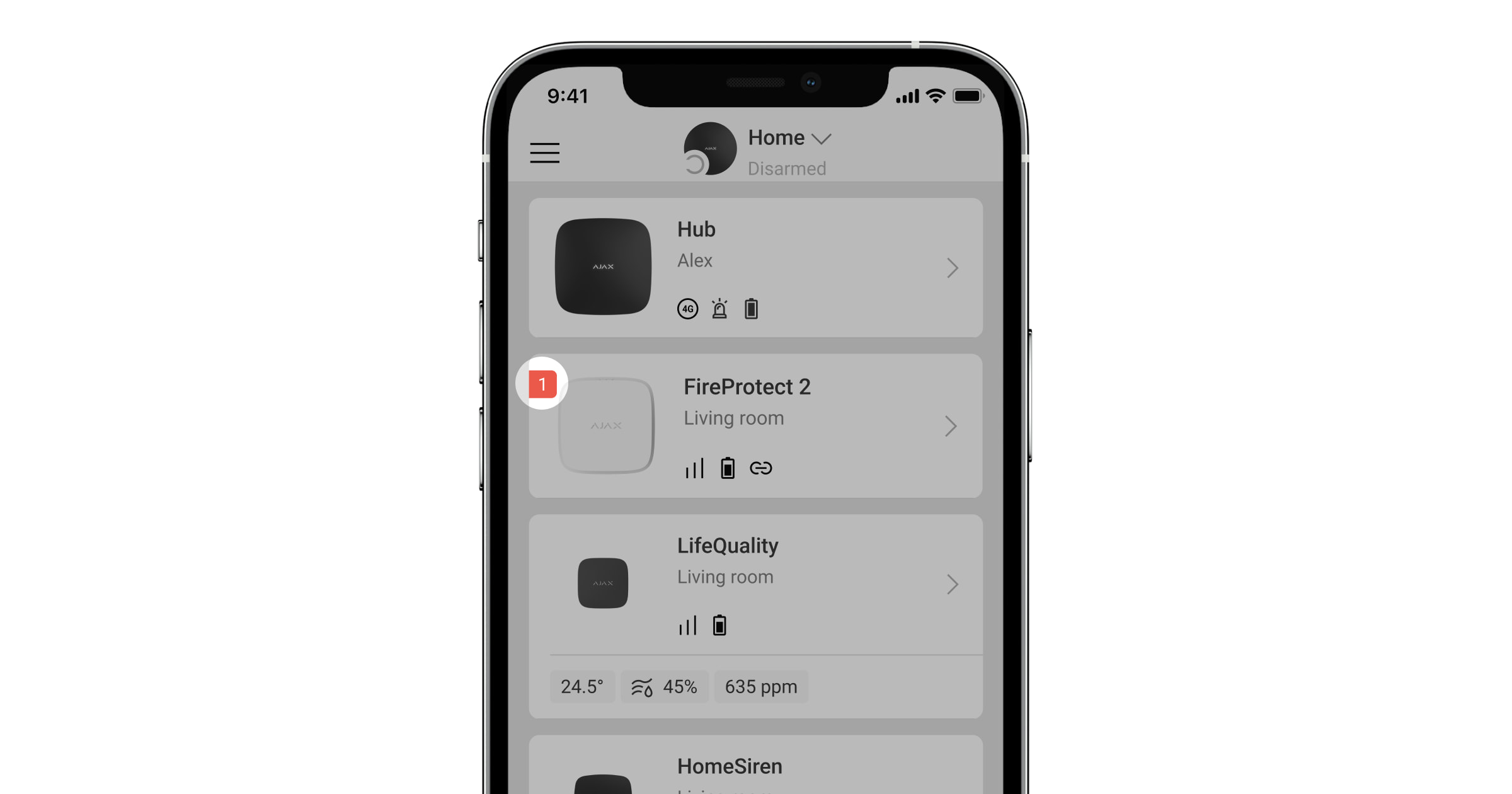
FireProtect 2 arızası tespit edilirse (örneğin, hub ile bağlantı yoksa), arıza sayacı Ajax uygulamalarındaki cihaz alanında görüntülenir.
Tüm arızalar dedektör Durumlarında gösterilir. Arızalı alanlar kırmızı renkle gösterilecektir.
Cihaz, arızaları AİM’ye ve anlık bildirimler ve SMS yoluyla kullanıcılara bildirir.
FireProtect 2 (Heat) arızaları
- Hub veya telsiz sinyali kapsama alanı genişletici ile iletişim yoktur.
- Dedektörün muhafazası açık.
- Düşük pil şarjı seviyesi.
- Donanım arızası (dedektörün bir veya daha fazla sensöründe arıza).
Bakım
Dedektör kendi kendini test eden bir sisteme sahiptir ve kullanıcı veya kurulumcu müdahalesi gerektirmez. İnsanları alarm sesine ve LED göstergeye alıştırmak için periyodik olarak kendi kendine test yapmanızı öneririz.
Ajax hub’larına bağlı FireProtect 2 cihazları genellikle rutin test gerektirmez. Bağlı tüm cihazlar, olası Arızalar veya Düşük pil için sürekli olarak izlenir.
Ancak, bina sakinlerinin sistemin yangın alarm sinyallerine aşina olmalarını sağlamak için tüm kullanıcıların FireProtect 2 cihazlarını periyodik (aylık)* olarak test etmelerini öneriyoruz.
* Lütfen yerel yönetmeliklere göre daha sık (örneğin haftalık) test yapmak gerekebileceğini unutmayın.
Dedektör muhafazasını toz, örümcek ağı ve diğer maddelerle kirlendikçe temizleyiniz. Ekipman bakımı için uygun yumuşak kuru bir bez kullanınız. Alkol, aseton, benzin ve aktif çözücü içeren başka maddeler kullanmayınız.
Dedektörün çalışma ömrü 10 yıldır. Bu süreden sonra sensörlerin hassasiyeti azalır. Tesislerde kesintisiz yangın koruması sağlamak için dedektörün yenisiyle değiştirilmesini öneriyoruz.
Dedektörün değiştirilebilir pillere sahip versiyonu (adında RB vardır) 5 yıla kadar hazır kurulu pillerle çalışır. Piller boşaldıktan sonra, yenileriyle değiştiriniz.
Kapalı pilli bir dedektör (adında SB olan), pilleri boşaldıktan sonra yenisiyle değiştirilmelidir.
Pillerin doğru kutuplarla takıldığından emin olunuz. Kutuplar, muhafazanın içinde işaretlenmiştir. Dedektörün doğru çalışıp çalışmadığını kontrol etmek için lütfen Ajax uygulamalarıyla veya piller değiştirildikten sonra Test/Sessiz düğmesine basarak kendi kendine testi yapınız.
Teknik özellikler
Garanti
Limited Liability Company “Ajax Systems Manufacturing” ürünlerinin garantisi satın alındıktan sonra 2 yıl boyunca geçerlidir.
Cihaz düzgün çalışmıyorsa, lütfen önce Ajax Teknik Destek ile iletişime geçiniz. Vakaların çoğunda teknik sorunlar uzaktan çözülebilir.
Teknik Destek ile iletişime geçin
